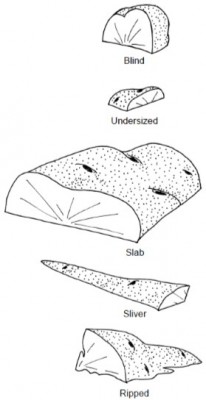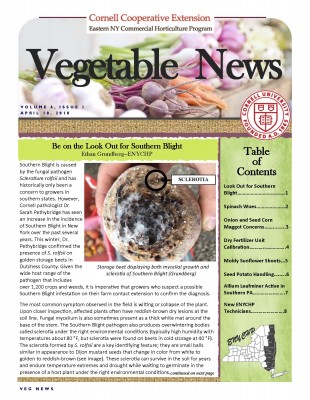Best Practices for Seed Potato Handling
Chuck Bornt, Team Leader, Extension Vegetable Specialist
Eastern New York Commercial Horticulture
I know a few of you have already received your seed potato orders and I think many more will be arriving this week; here are a few thoughts about seed handling and cutting.
First, I understand that when we pay for seed we want to use everyone - but, consider the price of cutting and planting diseased seed? I continue to see more diseases like Silver Scurf (which tends to show up more in storage after harvest) every year. Grade hard and if you see anything that doesn't look right, err on the side of caution and get rid of it.
Cutting seed (information excerpted from University of Maines "Bulletin #2412, Selecting, Cutting and Handling Potato Seed"):
· Disinfect equipment including knives and mechanical cutters before each seed cutting session. Keep knives sharp and straight to prevent ripping the potato surface.
· Warming seed: Potatoes should be warmed to 45—50O Fahrenheit prior to cutting.
· Cut seed tubers into blocky pieces about 1.75 -2.0 ounces in size with at least one eye. Pieces under 1.5 ounces should not be planted. Tubers weighing between 1.5 ounces but under 3.0 ounces should be planted whole. Tubers 3.0—5.0 ounces should be cut into two pieces; 5.0—7.0 ounce tubers should be cut into three pieces.
· Avoid blind pieces (no visible eyes) slab, sliver cuts or ripped pieces as they tend to have less vigor and may result in poor stands.
· Once cut, cool the cut seed to 38 to 40 degrees F and provide good air circulation with relative humidity levels at 85 to 95 percent for 6—10 days to promote healing and prevent dehydration.
· Re-warm seed again for two days before planting to get sprouts growing again and to avoid condensation on the seed.
· Cut potato seed is easily bruised and damaged areas allow decay organisms (on seed or in the soil) to infect the seed piece resulting in slower emergence and less stored energy to promote early growth.
For more information visit the following link to the University of Maine Bulletin 412: https://extension.umaine.edu/p...
 Size of potato piece affects early plant vigor. These are cuts to avoid if possible when cutting potato seed. (source: Bulletin #2412, Selecting, Cutting and Handling Potato Seed, University of Maine)
Size of potato piece affects early plant vigor. These are cuts to avoid if possible when cutting potato seed. (source: Bulletin #2412, Selecting, Cutting and Handling Potato Seed, University of Maine) This article was published in the April 18th 2018 ENYCHP Veg News, to see the full newsletter click: https://rvpadmin.cce.cornell.e...
This article was published in the April 18th 2018 ENYCHP Veg News, to see the full newsletter click: https://rvpadmin.cce.cornell.e...

Upcoming Events
What is my vine trying to tell me?
May 15, 2024 : What is my vine trying to tell me?
Plattsburgh, NY
Are your grapevines showing signs of discoloration or stunted growth? Don't ignore these warning signs! Join us on May 15th at the Clinton County CCE office to learn about the essential nutrients that grapevines require to thrive, identify the symptoms of nutrient deficiencies, and how to fix them. Don't miss out on this opportunity to improve your grapevine cultivation skills! Attendance is free, but registration is required.
How man's best friend can help find Spotted Lanternfly
May 21, 2024
Millbrook, NY
Come and join us at the Dutchess County CCE office on May 21st for a special demonstration by Jennifer Fimbel, the Agriculture and Horticulture Program Leader with Dutchess County CCE. You will get to see her SLF K9 Cole in action as they demonstrate how man's best friend can be used to detect the Spotted Lanternfly. Attendance is free, but registration is required
What is my vine trying to tell me?
May 22, 2024 : What is my vine trying to tell me?
Greenwich, NY
Are your grapevines showing signs of discoloration or stunted growth? Don't ignore these warning signs! Join us on May 22nd at the Washington County Fair Grounds to learn about the essential nutrients that grapevines require to thrive, identify the symptoms of nutrient deficiencies, and how to fix them. Don't miss out on this opportunity to improve your grapevine cultivation skills! Attendance is free, but registration is required.












































